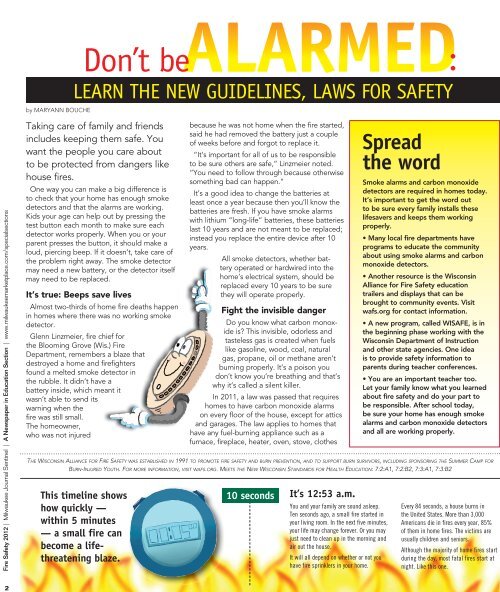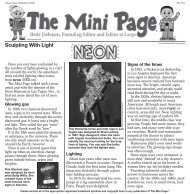Download the Fire Safety Section PDF - Newspapers In Education
Download the Fire Safety Section PDF - Newspapers In Education
Download the Fire Safety Section PDF - Newspapers In Education
You also want an ePaper? Increase the reach of your titles
YUMPU automatically turns print PDFs into web optimized ePapers that Google loves.
<strong>Fire</strong> <strong>Safety</strong> 2012 | Milwaukee Journal Sentinel | A Newspaper in <strong>Education</strong> <strong>Section</strong> | www.milwaukeemarketplace.com/specialsections<br />
2<br />
by Maryann Bouche<br />
alarmed<br />
don’t be :<br />
Learn <strong>the</strong> new guideLines, Laws for safety<br />
Taking care of family and friends<br />
includes keeping <strong>the</strong>m safe. You<br />
want <strong>the</strong> people you care about<br />
to be protected from dangers like<br />
house fires.<br />
One way you can make abig difference is<br />
to check that your home has enough smoke<br />
detectors and that <strong>the</strong> alarms are working.<br />
Kids your age can help out by pressing <strong>the</strong><br />
test button each month to make sure each<br />
detector works properly. When you or your<br />
parent presses <strong>the</strong> button, it should make a<br />
loud, piercing beep. If it doesn’t, take care of<br />
<strong>the</strong> problem right away. The smoke detector<br />
may need anew battery, or <strong>the</strong> detector itself<br />
may need to be replaced.<br />
It’s true: Beeps save lives<br />
Almost two-thirds of home fire deaths happen<br />
in homes where <strong>the</strong>re was no working smoke<br />
detector.<br />
Glenn Linzmeier, fire chief for<br />
<strong>the</strong> Blooming Grove (Wis.) <strong>Fire</strong><br />
Department, remembers a blaze that<br />
destroyed a home and firefighters<br />
found a melted smoke detector in<br />
<strong>the</strong> rubble. It didn’t have a<br />
battery inside, which meant it<br />
wasn’t able to send its<br />
warning when <strong>the</strong><br />
fire was still small.<br />
The homeowner,<br />
who was not injured<br />
This timeline shows<br />
how quickly —<br />
within 5minutes<br />
—asmall fire can<br />
become a lifethreatening<br />
blaze.<br />
because he was not home when <strong>the</strong> fire started,<br />
said he had removed <strong>the</strong> battery just a couple<br />
of weeks before and forgot to replace it.<br />
“It’s important for all of us to be responsible<br />
to be sure o<strong>the</strong>rs are safe,” Linzmeier noted.<br />
“You need to follow through because o<strong>the</strong>rwise<br />
something bad can happen.”<br />
It’s a good idea to change <strong>the</strong> batteries at<br />
least once a year because <strong>the</strong>n you’ll know <strong>the</strong><br />
batteries are fresh. If you have smoke alarms<br />
with lithium “long-life” batteries, <strong>the</strong>se batteries<br />
last 10 years and are not meant to be replaced;<br />
instead you replace <strong>the</strong> entire device after 10<br />
years.<br />
All smoke detectors, whe<strong>the</strong>r battery<br />
operated or hardwired into <strong>the</strong><br />
home’s electrical system, should be<br />
replaced every 10 years to be sure<br />
<strong>the</strong>y will operate properly.<br />
Fight <strong>the</strong> invisible danger<br />
Do you know what carbon monoxide<br />
is? This invisible, odorless and<br />
tasteless gas is created when fuels<br />
like gasoline, wood, coal, natural<br />
gas, propane, oil or methane aren’t<br />
burning properly. It’s a poison you<br />
don’t know you’re breathing and that’s<br />
why it’s called a silent killer.<br />
<strong>In</strong> 2011, a law was passed that requires<br />
homes to have carbon monoxide alarms<br />
on every floor of <strong>the</strong> house, except for attics<br />
and garages. The law applies to homes that<br />
have any fuel-burning appliance such as a<br />
furnace, fireplace, heater, oven, stove, clo<strong>the</strong>s<br />
10 seconds<br />
It’s 12:53 a.m.<br />
You and your family are sound asleep.<br />
Ten seconds ago, a small fire started in<br />
your living room. <strong>In</strong> <strong>the</strong> next five minutes,<br />
your life may change forever. Or you may<br />
just need to clean up in <strong>the</strong> morning and<br />
air out <strong>the</strong> house.<br />
It will all depend on whe<strong>the</strong>r or not you<br />
have fire sprinklers in your home.<br />
Spread<br />
<strong>the</strong> word<br />
Smoke alarms and carbon monoxide<br />
detectors are required in homes today.<br />
It’s important to get <strong>the</strong> word out<br />
to be sure every family installs <strong>the</strong>se<br />
lifesavers and keeps <strong>the</strong>m working<br />
properly.<br />
• Many local fire departments have<br />
programs to educate <strong>the</strong> community<br />
about using smoke alarms and carbon<br />
monoxide detectors.<br />
• Ano<strong>the</strong>r resource is <strong>the</strong> Wisconsin<br />
Alliance for <strong>Fire</strong> <strong>Safety</strong> education<br />
trailers and displays that can be<br />
brought to community events. Visit<br />
wafs.org for contact information.<br />
• A new program, called WISAFE, is in<br />
<strong>the</strong> beginning phase working with <strong>the</strong><br />
Wisconsin Department of <strong>In</strong>struction<br />
and o<strong>the</strong>r state agencies. One idea<br />
is to provide safety information to<br />
parents during teacher conferences.<br />
•You are an important teacher too.<br />
Let your family know what you learned<br />
about fire safety and do your part to<br />
be responsible. After school today,<br />
be sure your home has enough smoke<br />
alarms and carbon monoxide detectors<br />
and all are working properly.<br />
The Wisconsin AlliAnce for fire sAfeTy WAs esTAblished in 1991 To promoTe fire sAfeTy And burn prevenTion, And To supporT burn survivors, including sponsoring The summer cAmp for<br />
burn-injured youTh. for more informATion, visiT WAfs.org. meeTs The neW Wisconsin sTAndArds for heAlTh educATion: 7:2:A1, 7:2:b2, 7:3:A1, 7:3:b2<br />
Every 84 seconds, a house burns in<br />
<strong>the</strong> United States. More than 3,000<br />
Americans die in fires every year, 85%<br />
of <strong>the</strong>m in home fires. The victims are<br />
usually children and seniors.<br />
Although <strong>the</strong> majority of home fires start<br />
during <strong>the</strong> day, most fatal fires start at<br />
night. Like this one.

















